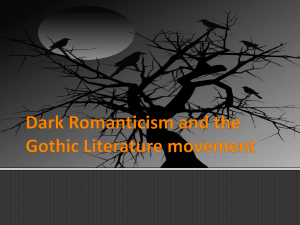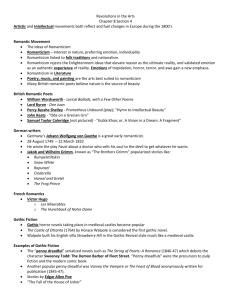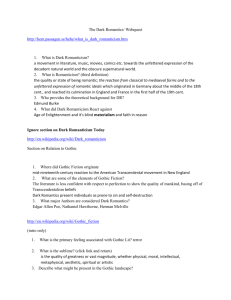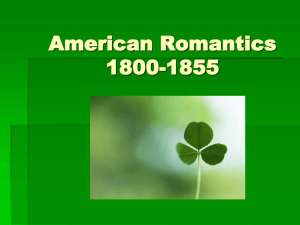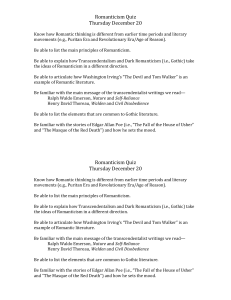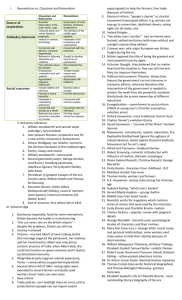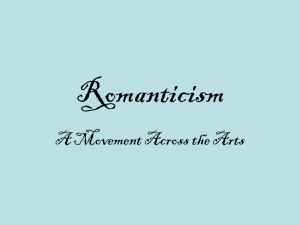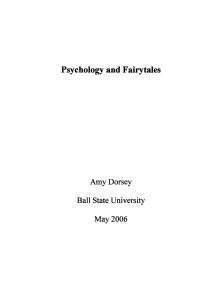Revolutions in the Arts
advertisement
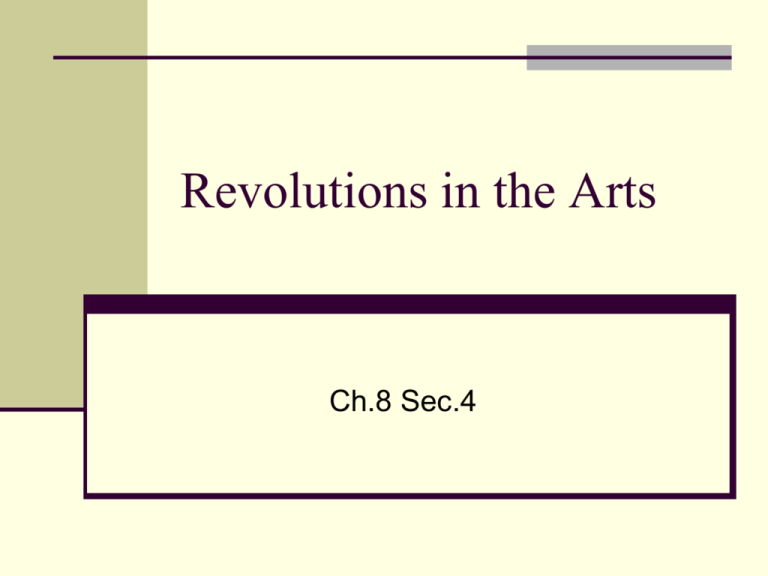
Revolutions in the Arts Ch.8 Sec.4 Romanticism Movement that reflected deep interest both in nature and in the thoughts and feelings of the individual. Enlightenment idea of reason gave way to this movement in art and ideas. Characteristics Emphasized inner feelings, emotions, and imagination Focused on mysterious, supernatural, exotic, grotesque, or horrifying Idealized the past as simpler and nobler time Glorified heroes and heroic actions Cherished folk traditions, music, and stories Valued common people and the individual Promoted radical change and democracy Romanticism Expressions Poetry- to romantics poetry was the highest form of expression Writing- novels, fairytales, and gothic novels Music- emotion dominated the music produced by romantic composers. Paintings- depicted romanticism ideas Poetry British poets William Wordsworth and Samuel Taylor Coleridge honored nature as the source of truth and beauty Lord Byron and Percy Bysshe Shelley wrote poems celebrating heroes, love, and the beauty of nature. “She walks in beauty, like the night Of cloudless climes and starry skies; And all that's best of dark and bright Meet in her aspect and her eyes: Thus mellow'd to that tender light Which heaven to gaudy day denies.” -Lord Byron (1788-1824) Writing- Romantics Johann Wolfgang von Goethe Wrote The Sorrows of Young Werther that detailed a man’s hopeless love for a married woman that leads him to suicide. Victor Hugo Wrote romantic works that reflected fascination with history and the individual. Hunchback of Notre Dameshows the struggles of individuals against a hostile and oppressive society Writing Fairytales Jakob and Wilhelm Grimm- inspired by romanticism, they collected German fairytales and created a dictionary. Fairytales were not suitable for children, but have been changed over the years Little Red Riding Hood Hansel and Gretel Writing- Gothic Novels Gothic horror stories that took place in medieval Gothic castles. Filled with fearful, violent, and supernatural events Mary Shelley wrote one of the earliest and most successful gothic horror stories......Frankenstein! Music Composers moved away from the tightly controlled, formal compositions of the Enlightenment period. They celebrated heroism and national pride as music became part of middle-class life Guiseppe Verdi and Richard Wagner brought European opera to a dramatic and theatrical high point. Ludwig van Beethoven Went from classical to romantic compositions Ninth Symphony soars, celebrating freedom, dignity, and the triumph of the human spirit. Paintings In their eagerness to explore emotion, romantic artists had certain favorite subjects: nature, love, religion, and nationalism Eugene Delacroix Realism Mid 19th century was affected by rapid industrialization. Growing class of industrial workers lived grim lives in dirty, crowded cities. Industrialization made romantic dreams pointless. In literature and visual arts, realism showed life as it was, not as it should be. Realism- Photography Technological advancements allowed for mass distribution of photos that gained a wide audience. Realism-Writing Depicted actual events in life that would allow more details to be revealed. Charles Dickens Described London’s working poor. Emile Zola Novels exposed miseries of French workers in small shops, factories, and coal mines. Shock readers and sparked reforms of labor laws in France Realism-Paintings Painters portrayed everyday life as it was Gustave Courbet The Stone Breakers Impressionism Beginning in the 1860s, painters in Paris reacted to the realist style. Tried to show their impression of a subject or moment in time. Used pure, shimmering colors to capture a moment seen at a glance. Impressionism-Paintings Showed a more positive view of urban society Instead of abused workers, they showed shop clerks and dock workers enjoying themselves Claude Monet Impressionism-Music Composers used different combinations of instruments, tone patterns, and music structures to make listens feel the mood. Ex: feel a warm summer day, or the sight of the sea Composers- Maurice Ravel and Claude Debussy
